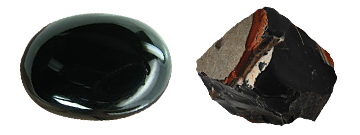 Photo of Onyx in Processed & Rough Form
Photo of Onyx in Processed & Rough Form
Onyx is a mineral with a hardness of 7 out of 10 on the Mohs scale of mineral hardness [?]. These Trigonally structured gems are made of silicon dioxide, their full chemical compound being SiO2.
Onyx is a translucent to semitransparent variety of Agate, which in turn is a variety of Chalcedony or cryptocrystalline quartz that is porous and consists of straight or parallel banded agate of alternating shades of milky white and black, gray and black, black and red, white and red, white and brown.
The term onyx has been erroneously applied as a suffix to Brazilian onyx, Mexican onyx, Oriental onyx, cave onyx, etc., which are calcium carbonate minerals.
But the term "onyx" in connection with calcium carbonate or onyx marble is only the structural similarity with chalcedony onyx but not the composition.
Therefore, the truest reference of "Onyx" isto the chalcedony agate variety.
Onyx's larger family of agates are found as nodules or geodes in siliceous volcanic rocks (melaphyre, prophyry) with sizes varying from a fraction of an inch to a circumference of several yards. The bands are formed by rhythmic crystallization, but scientific opinions vary as to how.
Agate nodules are found worldwide and many countries will claim the finest specimens so any attempt at a complete list or evaluation of deposits would not significantly advance knowledge.
Onyx is also a misleading term for artificially blue, red, black, or green dyed unbanded chalcedony. The blue colored is known as Swiss lapis or German lapis, Italian lapis.
Onyx is also used as an adjective meaning parallel banded minerals such as onyx marble, onyx obsidian, black onyx, and niccolo. It is also used to describe black dyed glass, or jet imitations.
Onyx is also different from Onyx marble, which is a translucent, hard, compact, dense variety of banded calcite or sometimes aragonite, which consists of parallel bands of calcite or aragonite similar to onyx. The color is usually white, green, grayish, red, or brown resembling true onyx in appearance.
What are the defining gemological properties?
Composition: Microcrystalline quartz Hardness: 6.5-7 Mohs Refractive Index: 1.530-1.540 Specific Gravity: 2.55-2.67 Structure: Cryptocrystalline Parallel banding distinctive
What determines natural color patterns?
Classic onyx: Black and white bands Sardonyx: Brown/red and white bands Natural black rare: Usually enhanced Band thickness varies by formation Parallel versus angular banding crucial for identification
What are key treatment indicators?
Sugar-acid treatment common for black Dye concentration patterns Natural color zoning patterns Surface texture variations Artificial color boundaries
What affects carving quality?
Band orientation Material consistency Layer thickness Surface polish potential Structural integrity Color contrast strength
What are diagnostic testing methods?
Magnification reveals structure Chelsea filter reaction Specific gravity testing UV fluorescence examination Surface luster analysis
What determines value in carved pieces?
Artistic merit Band utilization Color contrast quality Size of piece Treatment status Historical significance
What are key durability factors?
Excellent for all jewelry uses Resistant to everyday wear Good chemical resistance Heat stable Takes high polish Resistant to light exposure
The specific gravity [?] for Onyx is 2.61, its refractive index [?] is 1.53-1.54, and its double refraction [?] is 0.004.
History
Material from deposits in Egypt features in antiquities over 3,000 years old.
It was thought that the agate bands crystallize gradually in the hollows formed formed by gas bubbles from a siliceous solution. Now it is more supported that their formation is simultaneous with that of the matrix rock. According to this idea, the liquid drops of the silicic acid cool with the cooling rock and produce a layered crystallization from the outside. The various bands -especially those close to the outer wall may vary in thickness, but normally their thicknesses remain constant throughout the nodule. The outer wall and the outermost layer may form a white crust due to weathering.
Industrial Usages
Onyx is used in making cameos. Almost all onyx in trade is dyed to emphasize the concentric structures. Cameos are made from onyx with the figure carved in white in relief against the black background.
Much agate is dyed to give strong and commercially acceptable colours. The material is sawn and shaped before dyeing. Immersion in a hot sugar solution followed by immersion in concentrated sulphuric acid and heating gives black; a blue colour, once called Swiss lapis, is produced by immersion in potassium ferrocyanide and subsequent warming in a solution of ferrous sulphate to give a precipitate of Berlin blue.
Chromium alum or potassium dichromate may be used to give green or bluish green, and nickel compounds give a brighter, apple green.
Impregnation with iron compounds and heating may give reddish brown and red colours. Yellow to greenish yellow is obtained by heating dry agate that has been treated with concentrated hydrochloric acid.









